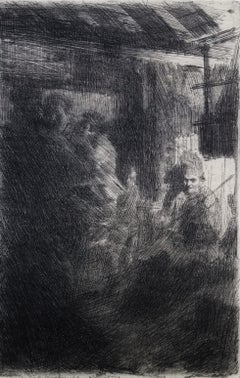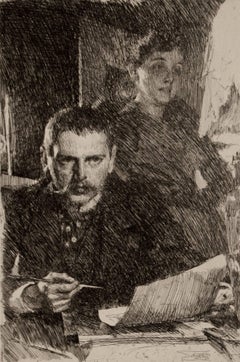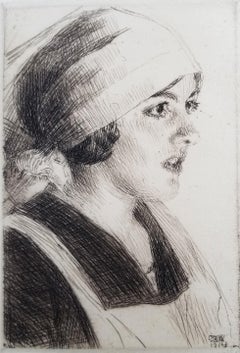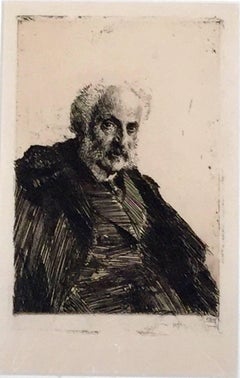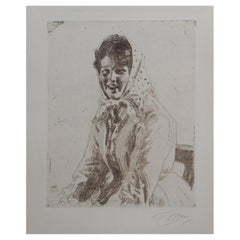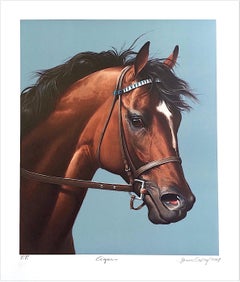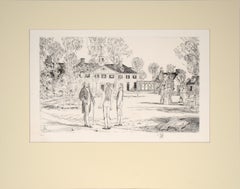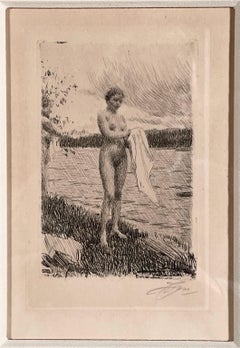Maternal Delight III, or Mothers Joy III, (In Swedish Modersglädje III) by Anders Zorn depicting a young woman lovingly playing with her child. A small amusing detail is the small child face visible on the lower left side, just outside the oval. This is an extremely rare etching and is one of two or possibly three known in existence of a so called cancellation proof. A cancellation proof etching of the Maternal Delight III is in the Boston Public Library Collection, USA.
Signed Zorn in the plate. When Zorn decided that the vey limited number of prints were all done he took his burin, (the steel cutting tool used in engraving also, back in history, called graver), and made cross hatched lines across the figures on the original plate, after which he made a couple of after proofs or cancellation proofs and the present etching is one of them. This gives the present work a special and interesting image of one of Zorns best and rarest etchings. Created in London 1883, the first year he made etchings.
Etching 276 x 406mm
Sheet circa 33,5 x 48cm
Literature
Asplund 6. Delteil. 5. Hjert & Hjert 6. Lidbeck 6.
Unfortunately some reflexes in the photos.
Anders Zorn (1860-1920) was a Swedish artist who attained international success as a painter, sculptor, and etching artist. He was to become one of Swedens foremost artists ever. No technique was foreign to him, he worked equally well with watercolors, wash technique or oil painting. The etching technique also attracted this virtuoso and the etchings contributed greatly to his success.
Between 1875 to 1880, Zorn studied at the Royal Swedish Academy of Arts in Stockholm, where he amazed his teachers with his talent. Members of the Stockholm Society approached him with commissions. In early 1881, Zorn met Emma Lamm, whose background was quite different from his. Emma Lamm was from a wealthy Jewish merchant family. She was interested in art and culture and, after a long engagement, they were married in 1885.
During the 1880s Zorn traveled extensively, to London, Paris, the Balkans, Spain, Italy, and the United States. In the 1890s when he was in Paris, he spent much time with Albert Edelfelt. He quickly became an international success and one of the most highly regarded painters of his era. In the beginning of Zorns career, it was primarily his skill as a portrait painter that gained him international acclaim, based principally upon his incisive ability to depict the individual character of his model, he came to portray many great people including three American Presidents: Grover Cleveland, William H. Taft, and Theodore Roosevelt.
Zorn also depicted Swedish dignitaries, for example King Oscar II in 1898, King Gustaf V in 1909, Queen Sophia in 1909, Prince Eugen in 1891, fellow artist Carl Larsson in 1897 and August Strindberg in 1910.
In the late 1880s, Zorn began working in the genre that is probably his hallmark for the general public, nude studies in the open air. Zorn had long been fascinated by the movements of water and the reflections of light on the water surface. Now Zorn chose to place a nude model by or in the water, with the aim of depicting people in nature.
When Zorn started the art of etching, he developed a technique with Rembrandt as a model, where he built up the motif with bursts of lines. The first etching was created in London in 1883, the same year as our Maternal Delight. Axel Herman Hägg, then active in London, was Zorn's teacher in this special technique. Hägg was the person Zorn depicted in his first etching. Zorn quickly mastered the etching technique itself and a unanimous art expert was able to conclude early on that Rembrandt had now found his equal.
At the age of 29, he was made a Chevalier de la Légion d'honneur at the Exposition Universelle 1889 Paris World Fair.
Zorn's reputation as an etcher spread across the world. Soon he could find his etchings in the major world metropolises in Europe and the USA. Zorn produced 289 different etchings, including portraits, genre studies and nude studies.
The motifs on Anders Zorn's graphic sheets are most often based on his own paintings, as ours, which is based on a watercolor he made in 1882 on his first trip to Spain. Even during Zorn's lifetime, his etchings were considered to be artistically superior to his paintings. As a result, his graphics quickly became sought after on the international art market. He was compared to Rembrandt, who as mentioned earlier was Zorn's great role model in the art of etching. Zorn was able to combine the old technique with his personal form of impressionism and the temporary and everyday with the universal. On the printing plates, one can study his outstanding etching technique, his characteristic play with parallel lines drawn in different directions, with varying degrees of force and intensity.
Zorn's art made him wealthy and he was thus able to build up a considerable collection of art. In their joint will, Anders and Emma Zorn donated their entire holdings to the Swedish State.
Some of his most important works can be seen at the National Museum of Fine Arts in Stockholm. Other museums holding major works by Zorn include the Musée d'Orsay in Paris, the Metropolitan Museum of Art in New York, and the Museum of Fine Arts, Boston. The Zorn Collections located in Mora and Garberg, Älvdalen, consist of four museums dedicated to the life and works of Anders Zorn. Shown there are extensive works of Zorn and his collected art.
The Bellman Prize (Bellmanpriset) is a literature prize for "an outstanding Swedish poet", every year awarded by the Swedish Academy. The prize was established by Anders Zorn and his wife Emma in 1920.
The motif: The present etching is based on a central and important work from Zorns first important trip to Spain, 1881-1882. After visiting Madrid and Seville, Zorn set off for Cádiz, tempted by the sea and the city’s women who were reputed to be the most beautiful in all of Spain.
In Maternal Delight, also translated to Mothers Joy and
Mothers Pride...
